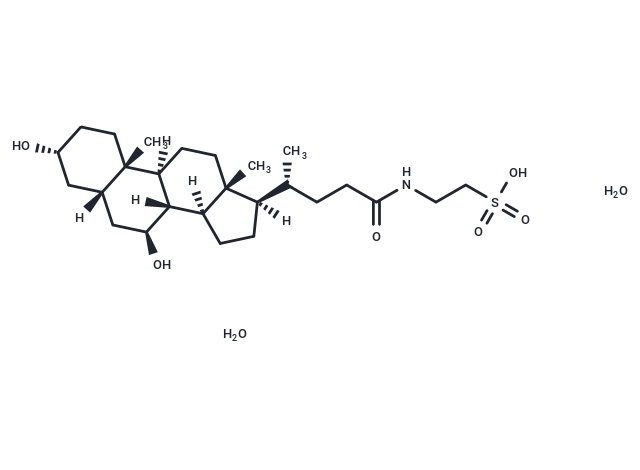Shopping Cart
- Remove All
 Your shopping cart is currently empty
Your shopping cart is currently empty

Tauroursodeoxycholate (TUDCA ,Taurolite) dihydrate is a water-soluble bile acid with endoplasmic reticulum stress inhibitory, mitochondrial stabilizing, and anti-apoptotic effects, which significantly reduces the expression of apoptotic molecules, such as Caspase-3 and Caspase-12, and inhibits ERK, reducing endoplasmic reticulum stress mediated cell death.

| Pack Size | Price | Availability | Quantity |
|---|---|---|---|
| 25 mg | $35 | In Stock | |
| 50 mg | $50 | In Stock | |
| 100 mg | $73 | In Stock | |
| 200 mg | $105 | In Stock | |
| 1 mL x 10 mM (in DMSO) | $39 | In Stock |
| Description | Tauroursodeoxycholate (TUDCA ,Taurolite) dihydrate is a water-soluble bile acid with endoplasmic reticulum stress inhibitory, mitochondrial stabilizing, and anti-apoptotic effects, which significantly reduces the expression of apoptotic molecules, such as Caspase-3 and Caspase-12, and inhibits ERK, reducing endoplasmic reticulum stress mediated cell death. |
| Alias | UR 906 dihydrate, TUDCA dihydrate, Tauroursodeoxycholic acid dihydrate, Taurolite dihydrate |
| Molecular Weight | 535.73 |
| Formula | C26H49NO8S |
| Cas No. | 117609-50-4 |
| Smiles | C[C@@]12[C@](CC[C@]2([H])[C@H](C)CCC(NCCS(=O)(O)=O)=O)([H])[C@@]3([H])[C@@](CC1)([H])[C@@]4([C@](C[C@@H](CC4)O)([H])C[C@@H]3O)C.O.O |
| Relative Density. | no data available |
| Storage | store at low temperature | Powder: -20°C for 3 years | In solvent: -80°C for 1 year | Shipping with blue ice. | |||||||||||||||||||||||||||||||||||
| Solubility Information | DMSO: 60 mg/mL (112 mM), Sonication is recommended. | |||||||||||||||||||||||||||||||||||
Solution Preparation Table | ||||||||||||||||||||||||||||||||||||
DMSO
| ||||||||||||||||||||||||||||||||||||

Copyright © 2015-2025 TargetMol Chemicals Inc. All Rights Reserved.